This is a free fortnightly newsletter about the New Zealand Net. If you would like to be notified by email when a new edition is published, please contact ZL1NZ.
Browse our Newsletter Archive and List of Net Tips.
Featured key

NZ-made Supreme semi-automatic key. Photo: telegraphkeys.com
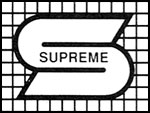 The Supreme semi-automatic key was one of only two or three ‘bugs’ commercially manufactured in New Zealand. These keys, sold by Tricity House in Christchurch during the 1970s and 1980s, were very nicely made and had an unusual feature.
The Supreme semi-automatic key was one of only two or three ‘bugs’ commercially manufactured in New Zealand. These keys, sold by Tricity House in Christchurch during the 1970s and 1980s, were very nicely made and had an unusual feature.
Later in this edition of NZ Net News, you can read about the Supreme bug and the man who made them.
* If you have an interesting key for this feature, please send me a nice clear photo and a few words describing it.
Quick notes
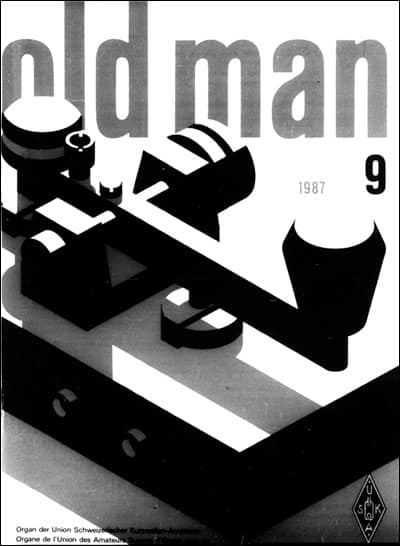 Cool magazine cover. Isn’t this a great bit of art? The Morse key graphic was used on all covers of the journal of the Swiss amateur radio society from 1978 to 1999. Although the magazine is in German, it has an English name: Old Man. Hmmm. Did the YLs have their own magazine?
Cool magazine cover. Isn’t this a great bit of art? The Morse key graphic was used on all covers of the journal of the Swiss amateur radio society from 1978 to 1999. Although the magazine is in German, it has an English name: Old Man. Hmmm. Did the YLs have their own magazine?
The 2021 Memorial Contest results have finally been announced and, to no one’s surprise, the overall winner was an NZ Net member (although he was using his contest callsign). Congratulations Paul!
The annual Jock White Field Days are next weekend. I have heard rumours that a couple of clubs are hoping to revive their long-dormant CW participation but, who knows, what with Covid likely to affect turnout. Good luck to all, and let’s hope for dry weather. Send me your JWFD CW photos for the next newsletter, please.
Keys to Good Code is an article by Bob Shrader W6BNB which appeared in 73 Amateur Radio Today in 1999. Bob described the various types of keys and how to use them well. I recommend this article particularly to new CW ops who may be confused by the many styles of key.
Break-In adds CW section. Starting with the current edition of our national amateur radio magazine, there will be a section in each issue devoted to CW (kind of appropriate given the name of the magazine, don’t you think?). The first article was on the SKCC, and I hear the editor has lined up a couple of NZ Net members to contribute articles.
Photo flashback

Pounding brass in Antarctica, c1965. The portable transceiver is a Collier & Beale 557HF.
See more about radio in Antarctica at maritimeradio.org.
Blenheim to join Reverse Beacon Network
New Zealand is set to get another receiver on the Reverse Beacon Network (RBN), hosted by the Marlborough Amateur Radio Club (MARC) with funding from FISTS Down Under (FDU).
The RBN is a great resource for CW operators. A global network of wideband receivers monitors amateur bands and automatically identifies the callsigns heard. These are then displayed online for anyone to view in real time at www.reversebeacon.net.
There are already three active RBN receivers in New Zealand. The busiest is at ZL4YL (Waimarama Heights, Hawke’s Bay) using a range of high-performance aerials. ZL2BR (New Plymouth) and ZL3X (Upper Moutere, near Nelson) have receivers, but report fewer signals than ZL4YL on an average day. (Also, RBN doesn’t hear everything. I find that I can copy some signals on my receiver that I don’t see reported by any RBN receiver – one of the mysteries of radio.)
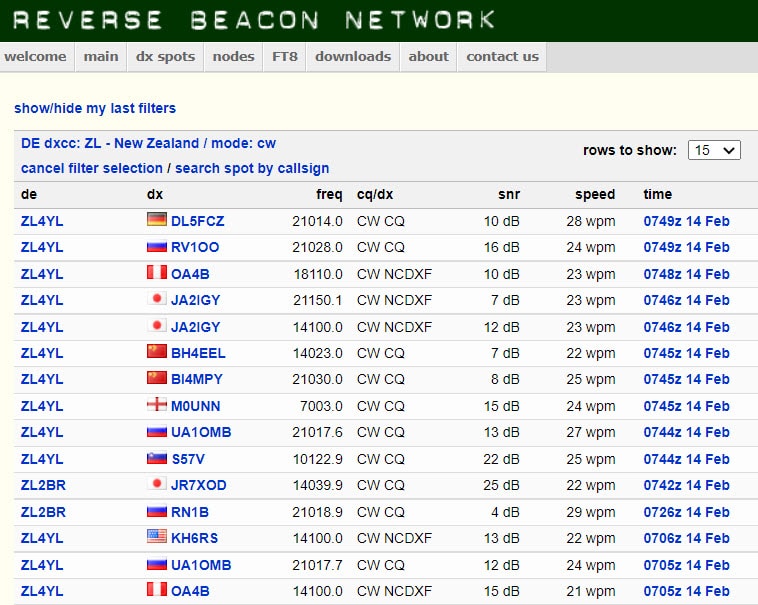
Here are just a couple of ways to use RBN.
- Choose a receiver that you’d like to monitor, or a set of receivers (e.g. all NZ receivers) and you’ll see what stations they are hearing (see screenshot above). I have often done this from my home office to see what DX is being heard in NZ, without having to walk to the shack and warm up the receiver. You can filter the reports by band and even by the locations of the DX stations that interest you, e.g. what European signals are being heard in NZ.
- See where your signal is being heard, by monitoring all receivers, but filtered to display only reports of your own callsign. Then call CQ and you may be surprised where you are being heard! Or filter to a particular location to see whether you are being heard there.
RBN receivers are often in low-noise locations so they may hear signals that the average amateur will not, but RBN displays the signal-noise ratio at each location, so you can judge whether you are likely to hear or be heard on any particular path in less-than-perfect conditions.
FISTS Down Under has a programme to help fund RBN receivers, and has recently agreed to support a proposal from MARC for a receiver.
MARC member Gerard van Antwerpen ZL2GV is project manager for the RBN receiver installation, and says he hopes to have it online in a few months. The receiver will be located in MARC’s building at Brayshaw Heritage Park in Blenheim.
“I have had an online SDR in mind for a while,” says Gerard, “mainly because our club’s remote station works through Remote Hams, which is Windows-only. As I don’t run that at home I could not listen to myself playing with QRP sets, so thought a more universal and accessible SDR would be nice. I also like that the RBN system keeps history, so you don’t have to watch it constantly.”
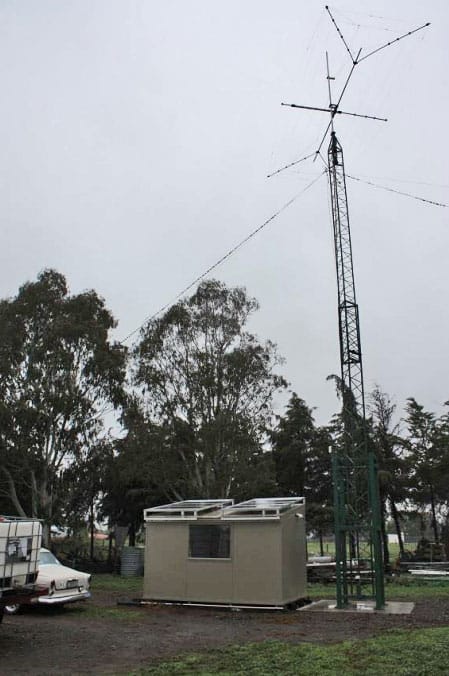
MARC’s ZL2KS remote HF station at Brayshaw Park
The new receiver will be a Red Pitaya STEMLAB 125-14 SDR. It will be connected to a computer running CW Skimmer software to process the data feed and then create the data required by the RBN system. The existing internet connection for the club’s remote HF station will be used to send the data to the RBN servers. A multiband wire receive antenna will be used initially, but could be changed to an active antenna if necessary.
“Nick ZL2NEB is looking into the software, and since we are on the site that’s also housing our 100-watt remote HF station we will need some input protection for the RBN receiver,” says Gerard.
“There’s no mains power, but plenty of battery capacity, so we need to see what’s best to run the computer, possibly an inverter for a desktop PC, or a laptop or other small unit running straight from 12 volts.”
David Smith ZL2WT, an FDU committee member, says FISTS is growing, with 54 members in New Zealand and 168 in Australia.
“FISTS Down Under is pleased to be able to support MARC in setting up their RBN receiver for the benefit of all CW operators,” says David.
Audio challenge
Ready for another audio challenge? Listen to this recording of a coast radio station and then send a radiogram to ZL1NZ telling me:
1. What is the callsign of the station? (Plus an easy bonus point if you tell me its location.)
2. What is the meaning of the signal sent at the start of the transmission?
[AUDIO NO LONGER AVAILABLE]
Eric Sorensen, key maker
By Herman VK2IXV
Supreme Morse ‘bug’ keys and Supreme Morse straight keys (Version 1) were made by Eric Andrew Sorensen from 1953 until 1989 and sold through Tricity House Ltd, a radio store located at 209 Manchester Street, Christchurch, New Zealand.
Eric was born on 22 May 1909 in Orepuki, Southland and was educated at Orepuki and Riverton schools. He became a very skilled fitter and turner, and was employed as a Quality Control Inspector by Andersons Engineering Ltd, a large Christchurch company. He worked for Andersons continuously over many years, the only exception being the five-year break for his wartime service.
Eric was a member of the first Naval Echelon that was posted to war service during WW2. From 1939 to 1943 he served as a ship’s telegraphist and was then deployed to the Western Approaches Operations Centre in Liverpool, England, which he helped commission and operate.
Upon returning to New Zealand, Eric was drafted to the Navy Office in Wellington to handle codes and ciphers. After being demobilised in 1945, he returned to Christchurch, to Andersons, and to the Canterbury Division of the Naval Reserve from which he retired in 1963 after 30 years of service.
In 1965 both Eric and his son Alan became licensed radio amateurs, ZL3OQ and ZL3JU respectively. It was logical that after many years of CW operation in the navy, Eric’s favourite mode of operation would be carried over into his ham radio life as well.
As a very young lad, Alan remembered his father spending many hours at work in his garage making the components for Morse keys. Alan said that “the machinery used in the manufacture of the components was totally home designed and homemade and it always worked wonderfully well.”
 Using his hand-built machines from about 1953 to 1989, Eric made many Morse straight keys and bugs, which were marketed by Tricity House.
Using his hand-built machines from about 1953 to 1989, Eric made many Morse straight keys and bugs, which were marketed by Tricity House.
Tricity House, mainly staffed by radio amateurs, was situated in central Christchurch City, where they sold and repaired small domestic appliances and wireless sets, and for many years it was the only outlet in Christchurch for amateur radio equipment and electronic components. ‘Supreme’ was a name that Tricity House used for the Morse keys made by Eric, and for various antennas made by Ron Parry ZL3VX. Tricity House closed in the 1990s.
Hundreds of Supreme keys were sold to ZL and VK amateurs. A great number were also sold to visiting ships’ radio officers, who took with them Tricity House catalogues. Many keys were sold and sent around the world by mail order.
Supreme bugs and straight keys have an excellent reputation, and were a tribute to Eric Sorensen, a fine man who became a Silent Key on 8 October 1990.
An unusual feature of the Supreme bug
Words and photos by Neil ZL1NZ, New Zealand Morse Key Directory
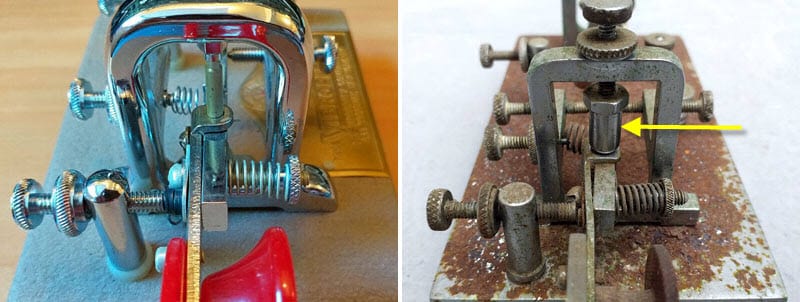
Many Supreme bugs have a sleeve over the pivot pin (see photo above right). Integrated with this sleeve is a hex nut that threads onto the trunnion screw.
What is the reason for this unusual arrangement? Well, I haven’t seen it discussed anywhere, but here is my theory:
After tightening the trunnion screw just enough to remove slop from the dot lever, one would then screw down the sleeve/nut to press downward on the hinge of the dash lever, reducing any slop in that lever. Compare this with the Vibroplex arrangement shown at left, where there is no such sleeve. The dash hinge on the Vibroplex has plenty of clearance, resulting in a lot of unnecessary up/down movement.
 The bottom of the sleeve on the Supreme bug, which pushes against the top of the dash hinge, is rounded, presumably to minimise friction when making dashes.
The bottom of the sleeve on the Supreme bug, which pushes against the top of the dash hinge, is rounded, presumably to minimise friction when making dashes.
There is a similar arrangement for the lower end of the pivot, with a trunnion screw inserted from the bottom of the base, then passing upward through a short sleeve with rounded top shoulders on which the bottom of the dash hinge bears. Once assembled, all adjustments were likely done via the top trunnion screw and upper sleeve/nut.
I’m not sure how well this arrangement worked. For one thing, although the Vibroplex has quite a loose hinge on the dash paddle, I don’t find it affects my keying significantly. Second: imposing a downward force on the dash hinge seems likely to make the dash paddle less responsive and create unnecessary wear. Third: I think the sleeve/nut arrangement could work loose over time, as I have not seen a locking nut on any of these bugs.
Are there any Supreme bug users out there who would like to comment?
Video: How to operate portable on 630 metres
This doesn’t look too hard, does it?!
Advertising archive
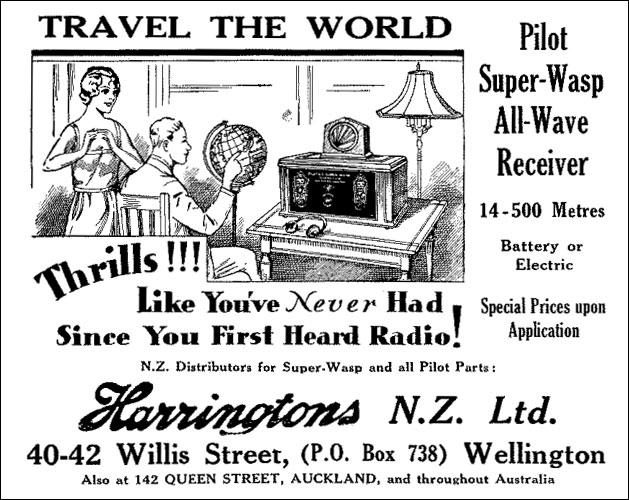
Break-In magazine, May 1931
Suggestions?
If you have suggestions on how to make the NZ Net better, or things you’d like to see covered in these updates, please contact ZL1NZ. You might even like to write something for the newsletter.
Thanks for reading, and I hope to hear you soon on the NZ Net!
—
Neil Sanderson ZL1NZ, Net Manager
New Zealand Net (NZ NET)
3535.0 kHz at 9pm NZT Mon-Fri



